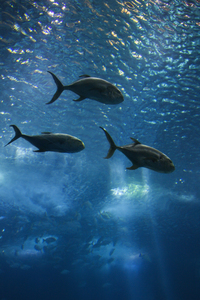Marine Protected Areas

The Benefits of Marine Protected Areas
How do MPAs benefit fisheries?
Marine protected areas with core ‘no-take’ reserves can play an important role in arresting and possibly reversing the global and local decline in fish populations and productivity. The global fish catch is reported to be in decline since the
late 1980s. Indications of this decline include:
- fishing for smaller and lower-value species;
- having to fish further from home bases; and
- the destruction or degradation of fish habitats in coastal areas.
The effects of a declining fish catch fall disproportionately on poor coastal communities, as an estimated 94% of all fishers are subsistence fishers, producing nearly half of the world’s fish for human consumption. In the face of increasing world population, reversing the decline and maintaining the high quality protein supply from the sea will require considerable improvement in the management of wild capture fisheries, aquaculture and the health of the
ecosystems upon which they depend.
There is a substantial weight of evidence in favour of the beneficial role of MPAs in a range of different types of fisheries, in different global localities, and within different fisheries management regimes. MPAs on their own are not sufficient as a single management tool, except possibly in small-scale subsistence fisheries where other management systems may not be very effective.
For fisheries, MPAs generally can be considered to provide four basic benefits:
- support for stock management, including:
– protection of specific life stages (such as nursery grounds);
– protection of critical functions (feeding grounds, spawning grounds);
– provision of spillover of an exploited species; and
– provision of dispersion centres for supply of larvae to a fishery.
- improved socio-economic outcomes for local communities;
- support for fishery stability; and
- ecological offsets
– trade-off for ecosystem impacts; and
– better understanding of impacts and options.
Support for stock management
Traditionally MPAs and reserves (including specific fisheries management measures such as closures and catch restrictions) have benefited fisheries through stock enhancement and management. Protection of habitat is important to key life cycle stages including spawning, juvenile settlement, nursery grounds and major feeding grounds. Strategically located protected areas provide sites for settlement and early growth of juveniles which when mature, spill over into adjacent fished areas.
Support for fishery stability
Studies of marine protected areas with core ‘no-take’ reserves established in coastal and island areas which have been overfished show a significantly improved fish catch and has led to sustained catch levels.
How do MPAs benefit tourism?
Tourism is now a primary source of income in many developing countries and frequently exceeds the value, particularly the foreign currency value, of marine fisheries in those nations.
In Australia the Great Barrier Reef attracts about 1.8 million tourist visits with the industry valued at over $A1 billion per year, compared to estimates of $A359 million for the annual worth of Great Barrier Reef fisheries.
Despite the importance to tourism of the quality of the natural environment, coastal and marine tourism areas are vulnerable to hasty and inappropriate development. Poorly managed tourism can lead to site degradation and a decline in visitor numbers.
The components of coastal and marine environments that are important for tourism include clear water, clean sandy beaches and opportunities to view marine life.
P o h n p e i , F e d e r a t e d S t a t e s o f M i c r o n e s i a
When government officials in Pohnpei established seven marine reserves in 1997, the idea did not have community support. But after one community began seeing increased fisheries as a result of setting aside their fishing area, others soon followed suit. Studies of these communitybased reserves showed that in less than two years the abundance of rabbitfish and parrotfish increased by 17% and 80%, respectively, while outside of the reserves there was a 45% decrease in rabbitfish and a 95% decrease in parrotfish. Today, Pohnpei has 11 marine reserves, including all seven of the originally designated areas.
‘than ever before.
A Tr a c k R e c o r d o f S u c c e s s
B i g g e r F i s h = M o r e F i s h
Larger, older fish reproduce faster and better than smaller, younger fish. The eggs of older fish are also healthier, and therefore more likely to survive into adulthood. For example, a typical six-inch reef fish such as the weke ‘ula (weke) spawns once a year, releasing 90,000 eggs. A 12-inch weke, on the other hand, spawns four to five times per year, releasing 45,000,000 eggs each time.
6″ = 90,000 eggs per year 12″ = 180 million eggs per year
~~~~~~~~~~~~~~~~~~~~~~~~~~~~~~~~~~~~~~~~~~~~~~~~~~~~~~~~~~~~~~~~~~~~~~~~~~~~~~~~~
